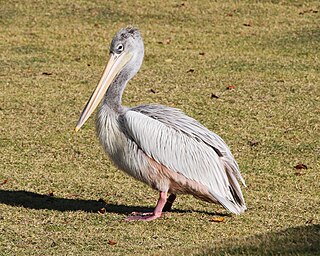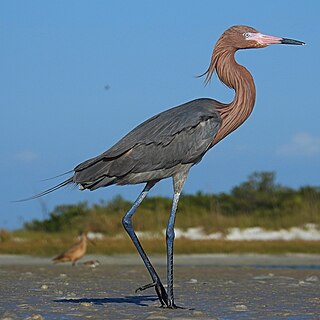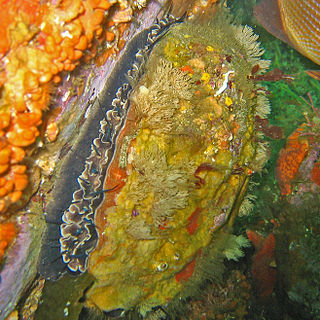Related Research Articles

The Mediterraneanshort-toed lark is a small passerine bird found in and around the Mediterranean Basin. It is a common bird with a very wide range from Canary Islands north to the Iberian Peninsula and east throughout North Africa to parts of the Middle East. The International Union for Conservation of Nature has rated its conservation status as being of "least concern".

The pink-backed pelican is a bird of the pelican family. It is a resident breeder in the swamps and shallow lakes of Africa and southern Arabia; it has also apparently extirpated in Madagascar.

The reddish egret is a medium-sized heron. It is a resident breeder in Central America, The Bahamas, the Caribbean, the Gulf Coast of the United States, and Mexico. There is post-breeding dispersal to well north of the nesting range. In the past, this bird was a victim of the plume trade.

The red-winged tinamou is a medium-sized ground-living bird from central and eastern South America. Other common names for the species include perdiz grande, rufous tinamou, and ynambu.

The blue-tailed damselfly or common bluetail is a damselfly, belonging to the family Coenagrionidae.

The chestnut-backed chickadee, formerly Parus rufescens, is a small passerine bird in the tit family, Paridae.
The Brazilian arboreal mouse is a South American rodent species of the family Cricetidae. It is found in the Atlantic Forest of southeast Brazil, often close to bamboo thickets. It can be distinguished from Rhagomys longilingua, the only other species in its genus, by the absence of spines among the hair. Formerly believed to be extinct after no sightings were recorded for over 100 years, the species has since been found in four localities. However, it is nowhere common, and all of these are forest fragments, and ongoing deforestation threatens the species' survival. For these reasons, the International Union for Conservation of Nature has assessed its conservation status as being "vulnerable".
Lonchocarpus urucu, or barbasco, is plant in the family Fabaceae. It is native to the tropical forests of Peru, as well as of Brazil and Guyana, growing from 100–1,800 metres (330–5,910 ft) above sea level. It was also recorded in Venezuela.
The Manusela mosaic-tailed rat is a species of rodent in the family Muridae. It is found only in Indonesia. It lives in the rainforests on the island of Seram in Indonesia. Specimens of it weigh 66.5g and have a head and body length of 118-135mm and a tail length of 126–140mm.

The black-tailed mosaic-tailed rat is a species of rodent in the family Muridae. It is endemic to the island of New Guinea.

The rufous scrubbird is a bird species in the family Atrichornithidae. It is endemic to Australia.

The rufous elephant shrew, rufous sengi or East African long-eared elephant-shrew is a species of elephant shrew in the family Macroscelididae. Found in Ethiopia, Kenya, Somalia, South Sudan, Tanzania and Uganda, its natural habitats are dry savanna and subtropical or tropical dry shrubland.

The Afghan pika is a species of small mammal in the pika family, Ochotonidae. It is found in Afghanistan, Iran, Pakistan and Turkmenistan and the IUCN lists it as being of "least concern".

Haliotis rufescens is a species of very large edible sea snail in the family Haliotidae, the abalones, ormer shells or paua. It is distributed from British Columbia, Canada, to Baja California, Mexico. It is most common in the southern half of its range.

Hydnum is a genus of fungi in the family Hydnaceae. They are notable for their unusual spore-bearing structures of teeth rather than gills. The best known are the edible species Hydnum repandum and H. rufescens. The word is derived from (h)udnon/ύδνον, an Ancient Greek word for truffle. The white or buff Hydnum repandum has a spore scatterer of still another shape. The smooth cap grows as wide as 8 inches across. The stem is off-center and is less than 2 inches long. Hydnum has many brittle, white teeth from which the spores drop. The mushrooms of the Hydnum group grow both on ground and on wood. Some species have teeth which hang from ascending branches, while other species have teeth which project downwards from the undersurfaces of dead wood. Most Hydnum are safe to eat.

Rhizedra lutosa, the large wainscot or Isle of Wight wainscot, is a species of moth of the family Noctuidae. It is native to the Palearctic realm. It has been introduced into eastern North America and is spreading.
Eupithecia rufescens is a moth in the family Geometridae. It is found in Japan.
Correbia rufescens is a moth of the subfamily Arctiinae. It was described by Rothschild in 1912. It is found in Colombia.
Nisaga simplex is a moth in the family Eupterotidae. It was described by Francis Walker in 1855. It is found in Bangladesh.
References
- ↑ Beccaloni, G.; Scoble, M.; Kitching, I.; Simonsen, T.; Robinson, G.; Pitkin, B.; Hine, A.; Lyal, C., eds. (2003). "Nisaga rufescens". The Global Lepidoptera Names Index . Natural History Museum . Retrieved May 26, 2018.